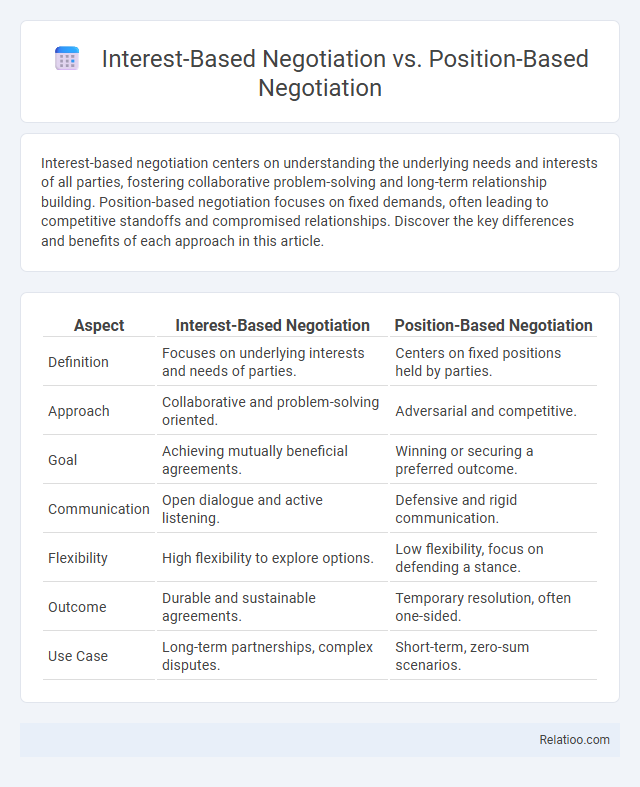Interest-based negotiation centers on understanding the underlying needs and interests of all parties, fostering collaborative problem-solving and long-term relationship building. Position-based negotiation focuses on fixed demands, often leading to competitive standoffs and compromised relationships. Discover the key differences and benefits of each approach in this article.
Table of Comparison
| Aspect | Interest-Based Negotiation | Position-Based Negotiation |
|---|---|---|
| Definition | Focuses on underlying interests and needs of parties. | Centers on fixed positions held by parties. |
| Approach | Collaborative and problem-solving oriented. | Adversarial and competitive. |
| Goal | Achieving mutually beneficial agreements. | Winning or securing a preferred outcome. |
| Communication | Open dialogue and active listening. | Defensive and rigid communication. |
| Flexibility | High flexibility to explore options. | Low flexibility, focus on defending a stance. |
| Outcome | Durable and sustainable agreements. | Temporary resolution, often one-sided. |
| Use Case | Long-term partnerships, complex disputes. | Short-term, zero-sum scenarios. |
Introduction to Negotiation Approaches
Interest-Based Negotiation emphasizes understanding the underlying needs and interests of parties to create mutually beneficial solutions, contrasting with Position-Based Negotiation, which centers on fixed demands or stances often leading to adversarial outcomes. Objectivity in negotiation involves applying impartial criteria and facts to guide discussions, reducing emotional bias and fostering fair agreements. These approaches shape negotiation dynamics, influencing collaboration levels and the potential for sustainable resolutions.
Defining Interest-Based Negotiation
Interest-Based Negotiation emphasizes understanding the underlying needs, desires, and concerns of all parties, fostering collaborative problem-solving and mutual gains. Unlike Position-Based Negotiation, which centers on fixed demands and often leads to adversarial interactions, Interest-Based approaches prioritize shared interests to create value and sustainable agreements. Objectivity in negotiation involves relying on factual criteria and impartial standards to guide decisions, complementing interest-based strategies by ensuring fairness and reducing emotional bias.
Understanding Position-Based Negotiation
Position-Based Negotiation involves parties holding onto fixed stances, often leading to competitive or adversarial interactions where each side aims to win their position. Understanding this approach helps You recognize the limitations of rigid bargaining, which can hinder creative problem-solving and mutually beneficial outcomes. Shifting focus toward Interest-Based Negotiation or Objectivity fosters collaboration by addressing underlying needs and facts rather than fixed demands.
Key Principles of Interest-Based Negotiation
Interest-Based Negotiation centers on understanding underlying needs, desires, and concerns to achieve mutually beneficial outcomes, contrasting with Position-Based Negotiation which focuses on fixed demands and often leads to adversarial stances. Key principles include separating people from the problem, focusing on interests rather than positions, generating options for mutual gain, and insisting on objective criteria to evaluate solutions. Emphasizing collaboration and open communication enhances trust and creativity, fostering sustainable agreements grounded in fairness and shared value.
Core Elements of Position-Based Negotiation
Position-Based Negotiation centers on fixed stances where each party defends a specific demand, often leading to adversarial interactions and limited problem-solving. Core elements include anchoring on initial positions, making concessions strategically, and focusing narrowly on winning rather than mutual gains. Your success depends on skillful argumentation and controlling the negotiation's scope rather than exploring underlying interests or objective criteria.
Pros and Cons of Interest-Based Negotiation
Interest-Based Negotiation emphasizes understanding the underlying interests of all parties to create mutually beneficial solutions, leading to stronger relationships and long-term agreements, while Position-Based Negotiation often results in rigid standoffs due to fixed demands. Your ability to collaborate and generate creative options improves with Interest-Based Negotiation, though it can be time-consuming and requires high levels of trust and communication skills. Objectivity supports both methods by fostering impartial evaluation, yet Interest-Based Negotiation excels in satisfying deeper needs beyond surface positions.
Advantages and Drawbacks of Position-Based Negotiation
Position-based negotiation centers on each party defending a fixed stance, which simplifies the process but often leads to rigid conflicts and suboptimal agreements. While its straightforward nature aids quick decision-making, it frequently overlooks underlying interests, fostering win-lose outcomes and limiting creative problem-solving. This approach contrasts with interest-based negotiation, which prioritizes mutual gains and leverages objective criteria to enhance collaboration and produce more sustainable solutions.
Comparing Outcomes: Interest-Based vs Position-Based Negotiation
Interest-Based Negotiation fosters collaborative problem-solving by addressing underlying needs and interests, often resulting in mutually beneficial and sustainable agreements that enhance long-term relationships. Position-Based Negotiation, by contrast, centers on fixed demands, which may lead to competitive standoffs, deadlocks, or compromise solutions that leave parties partially dissatisfied. Your negotiation outcomes improve significantly when you prioritize interests over positions, as this approach encourages open communication, creativity, and shared value creation.
Real-World Examples and Case Studies
Interest-based negotiation emphasizes understanding underlying needs and interests, as demonstrated in the 1995 Dayton Peace Agreement, where parties collaboratively addressed core concerns to end conflict. Position-based negotiation, often leading to stalemates, was evident during the 1980 U.S.-Iran hostage crisis, where rigid demands prolonged negotiations without resolution. Objectivity plays a crucial role in mediating disputes like the United Nations' involvement in the South China Sea arbitration, relying on international law and unbiased assessments to facilitate fair outcomes.
Choosing the Right Negotiation Strategy
Interest-based negotiation focuses on understanding and addressing the underlying needs and interests of all parties, fostering collaboration and mutually beneficial outcomes. Position-based negotiation centers on rigid stances that parties defend, often resulting in competitive, win-lose scenarios that may hinder long-term relationships. Your choice of negotiation strategy should consider the context, relationship dynamics, and desired outcomes, with objectivity serving as a critical tool to evaluate facts and maintain fairness throughout the process.

Infographic: Interest-Based Negotiation vs Position-Based Negotiation
 relatioo.com
relatioo.com